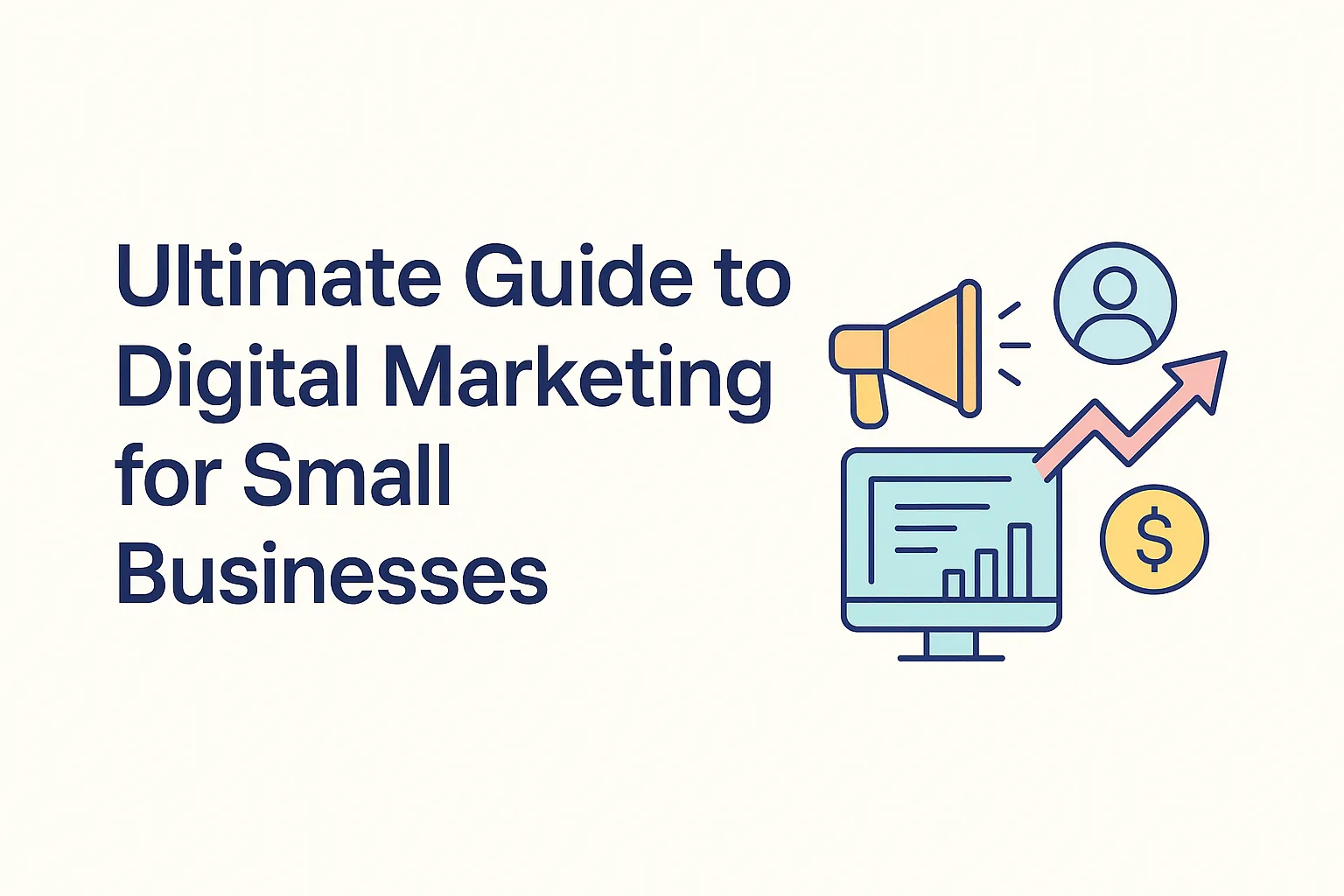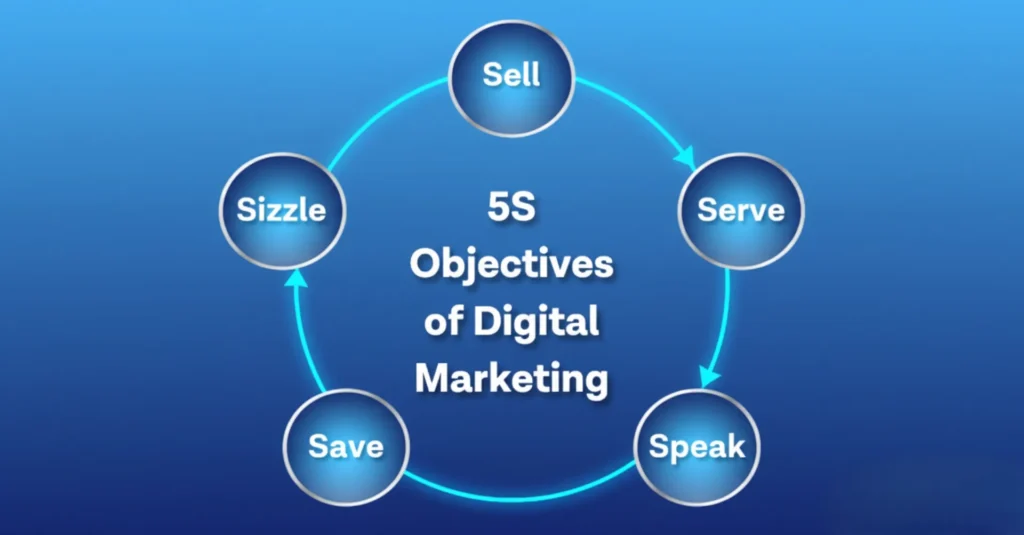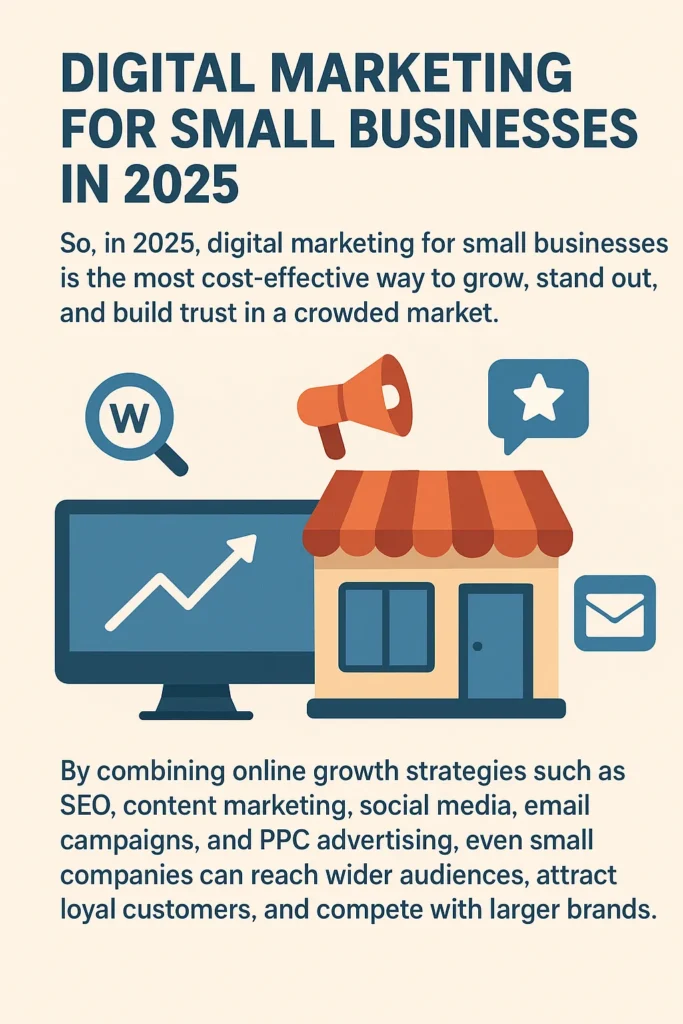- Why Digital Marketing matters for small businesses?
- What exactly does digital marketing mean for small businesses?
- Benefits of digital marketing for small businesses
- Core channels of digital marketing every small Business should know
- websites:
- SEO (Search Engine Optimization)
- Content Marketing:
- Social Media Marketing:
- Email Marketing:
- PPC (Pay-Per-Click) Advertising & Paid Search:
- Setting SMART Goals for Your Digital Marketing
- The SMART Breakdown:
- The 5S Framework:
- How to Build Your Digital Marketing Strategy
- How to measure Results and Adjust a Digital Marketing Strategy
- Next Steps: Scaling Your Digital Marketing Channels

Why Digital Marketing matters for small businesses?
Running a small business in 2025 is more challenging and more exciting than ever before. Customers are no longer just walking down the street to discover new shops or services; they’re searching online for products or services, browsing social media platforms, reading reviews and recommendations and clicking on ads that catch their attention.
If your business isn’t showing up where your customers are spending time online, you’re invisible to a huge portion of your market.
That’s where digital marketing for small businesses comes in. Unlike traditional marketing methods such as print ads, billboards, or radio spots—which can be expensive and hard to measure—digital marketing offers affordable, targeted, and trackable solutions. It gives small business owners the ability to compete with big brands, attract loyal customers, and grow sustainably without breaking the bank.
To get a complete understanding of the Ultimate Guide to Digital Marketing for Small Businesses, stay with me throughout this article and discover the key strategies to grow your business online
What exactly does digital marketing mean for small businesses?
At its simplest, it’s the use of online platforms and strategies—like search engine optimization (SEO), content marketing, social media, email campaigns, and pay-per-click (PPC) advertising—to promote products, services, and connect with customers. Each of these tools plays a role in helping you:
- Build a professional online presence with a well-designed website.
- Increase visibility by ranking higher in Google search results.
- Engage audiences through valuable content and social media posts.
- Nurture leads with email marketing and personalized campaigns.
- Gain instant visibility with PPC ads, such as Google Ads or Facebook Ads.
The opportunity here is massive. As of 2025, more than 5.56 billion people use the internet worldwide, and over 5.24 billion are active on social media. That means your potential customers are already online, actively looking for solutions, products, and businesses like yours. The only question is: will they find you or your competitor?
Imagine you are a local bakery. You could rely only on foot traffic and word of mouth, but with digital marketing, you can post daily photos on Instagram, run a Facebook ad for seasonal offers, or appear in Google search results when someone types “best chocolate cake near me.” Suddenly, you’re reaching not just the people walking past your door, but thousands of potential customers in your city.
The good news is that digital marketing doesn’t require a massive budget. With the right strategy, small businesses can achieve measurable results by starting small, testing what works, and scaling over time. Unlike traditional ads, digital platforms allow you to track every click, view, and conversion, so you can spend wisely and get the highest return on investment.
In this Ultimate Guide to Digital Marketing for Small Businesses, we’ll explore why digital marketing is essential in today’s competitive landscape, break down the core strategies you need to know, and share practical steps to help you get started. Whether you’re brand new to online marketing or looking to refine your current efforts, this guide will give you the tools and confidence to grow your business in the digital age.
Benefits of digital marketing for small businesses
Digital marketing provides measurable results, flexible strategies, and cost-effective growth.
Here are seven major benefits:
1. Cost-Effective Marketing with High ROI:
Digital marketing allows small businesses to market effectively without huge budgets. Content marketing and SEO often cost significantly less than traditional advertising but provide more qualified leads. Even a modest investment in social media ads or Google Ads can generate immediate visibility and revenue.
2. Wider Reach & Online Visibility:
Digital platforms break geographical barriers. SEO, social media campaigns, and PPC ads allow small businesses to reach local, national, and even global audiences, expanding brand awareness far beyond their immediate location.
3. Precision Targeting for the Right Audience:
Platforms like Facebook, Google, and LinkedIn allow advanced targeting by:
- Demographics
- Interests
- Behavior
- Location
This ensures your marketing reaches the most relevant audience, maximizing ROI and minimizing wasted spend.
4. Increased Customer Engagement:
Digital marketing fosters two-way communication. Engagement through comments, shares, polls, and emails builds stronger relationships. Customers who engage online are more likely to purchase again and become brand advocates.
5. Building and Strengthening Brand Reputation:
Online presence, customer reviews, and consistent high-quality content strengthen trust and credibility. Social proof, case studies, and client testimonials all contribute to a positive brand image.
6. Flexibility and Adaptability:
Digital campaigns are easy to adjust. Ads, posts, and emails can be updated or paused instantly, allowing small businesses to adapt quickly to trends, customer behavior, or competitor strategies.
7. Measurable Results and Data-Driven Decisions:
Analytics platforms like Google Analytics, Facebook Insights, and email tracking provide real-time data. Businesses can identify what works, optimize campaigns, and continually improve ROI.
Core channels of digital marketing every small Business should know

Digital marketing is built on a variety of channels, each designed to connect businesses with customers in different ways. Choosing the right mix depends on your goals, audience, and budget, but some channels are more critical than others for small businesses.
Let’s explore the most important digital marketing channels, starting with the ones every business should prioritize:
websites:
Your website is the foundation of your online presence. It’s where potential customers learn about your business, view your products or services, and decide whether to take the next step. A well-designed, user-friendly, and mobile-optimized website is essential for building trust and converting visitors.
So, your website is more than just a digital brochure—it’s the foundation of your brand online. Learn how to build and optimize a small business website that converts visitors into loyal customers in our full guide to websites for digital marketing
SEO (Search Engine Optimization)
SEO ensures your business shows up when people search online for products or services you offer. By optimizing your website with the right keywords, improving site speed, and creating relevant content, you can attract high-quality organic traffic without paying for ads.
Getting found online starts with SEO. From keyword research to local optimization, search engines can drive consistent traffic to your business. Dive deeper into actionable strategies in our complete SEO guide for small businesses
Content Marketing:
Valuable content builds credibility and trust. From blog posts and guides to videos and case studies, content marketing helps small businesses educate their audience, answer key questions, and position themselves as experts in their field.
So Content is what fuels your digital presence, building trust and authority with your audience. Discover proven tactics and content formats in our detailed guide to content marketing for small businesses.
Social Media Marketing:
Platforms like Instagram, Facebook, TikTok, and LinkedIn allow businesses to reach and engage directly with their audience. By sharing stories, promotions, and behind-the-scenes insights, small businesses can humanize their brand and grow loyal communities.
Therefore, social media isn’t just about likes—it’s about creating genuine connections and driving engagement. Explore platform-specific strategies in our ultimate social media marketing guide.
Email Marketing:
One of the most cost-effective channels, email allows you to nurture leads, retain customers, and deliver personalized content directly to inboxes. A strong email list can drive consistent sales and customer loyalty.
Email remains one of the highest ROI digital marketing channels for small businesses. Learn how to build, segment, and nurture your email list in our full email marketing guide
PPC (Pay-Per-Click) Advertising & Paid Search:
PPC campaigns on platforms like Google Ads or social media provide instant visibility. Unlike SEO, which takes time to build, PPC ensures your business appears in front of people who are actively searching for your services right now.
Sometimes the fastest way to reach your audience is through paid ads. Find out how to run cost-effective campaigns in our in-depth PPC advertising guide for small businesses
Beyond these primary channels, small businesses can also benefit from:
- Affiliate Marketing to leverage partnerships and referrals.
- Influencer Marketing to build trust through collaborations.
- Display Advertising to boost brand awareness.
- Mobile Marketing to reach customers on the go.
- Online PR & Marketing Communications to strengthen reputation.
- Audio Marketing & Podcasts to engage audiences in new ways.
- Instant Messaging Marketing via WhatsApp or Messenger for direct, real-time connections.
- Word of Mouth & Referrals, still one of the most powerful drivers of trust and sales.
In summary, while there are many digital marketing channels, small businesses should focus first on building a strong website, SEO, content marketing, social media, PPC, and email marketing strategy. Once those foundations are in place, additional channels like influencer marketing, affiliate programs, and online PR can amplify results.
Setting SMART Goals for Your Digital Marketing
Jumping into digital marketing without clear goals is like sailing without a compass—you might move forward, but not necessarily in the right direction. That’s why successful small businesses rely on the SMART framework to guide their marketing strategies. SMART goals are Specific, Measurable, Achievable, Relevant, and Time-bound, helping you create a roadmap that drives real business growth instead of vague “wish list” results.
The SMART Breakdown:
Specific (S):
Your goals should leave no room for confusion. Instead of saying, “I want more traffic,” clarify exactly what you’re aiming for, such as “Increase organic website traffic by 30%.” Define what you want to achieve, why it matters, who is responsible, and where it will happen.
Measurable (M):
If you can’t measure it, you can’t improve it. Attach key performance indicators (KPIs) to every goal, such as organic sessions, click-through rates, or lead conversions. For example, aim to “gain 500 new newsletter subscribers in three months.”
Achievable (A):
Ambition is great, but your goals must also be realistic. Look at your current resources, past performance, and market conditions before setting a target. For example, if your website traffic currently grows by 5% each month, a 50% jump in one month isn’t realistic—but 25% over six months could be.
Relevant (R):
Your goals should tie directly back to your broader business objectives. If your main aim is to increase sales, then goals around improving lead quality, building brand awareness, or enhancing customer retention should all support that bigger picture.
Time-bound (T):
Without deadlines, goals become endless tasks. Add a clear timeframe like “grow social media engagement by 15% in the next quarter” or “generate 50 qualified leads by year-end.” This urgency keeps your team focused and accountable.
Here is an example of a SMART Goal
Vague Goal: “Get more website visitors.”
SMART Goal: “Increase organic website traffic by 30% within six months by optimizing current blog posts and publishing two new SEO-focused articles per week.”
In addition to SMART, many marketers use the 5S’s to frame objectives.
The 5S Framework:

- Sell: Increase sales and revenue.
- Serve: Improve customer experience and satisfaction.
- Speak: Strengthen communication and engagement with your audience.
- Save: Reduce costs by optimizing campaigns and processes.
- Sizzle: Enhance your brand’s reputation and make it stand out.
By combining SMART goals with the 5S approach, small businesses can create digital marketing strategies that are clear, actionable, and aligned with long-term growth.
How to Build Your Digital Marketing Strategy
A strong digital marketing strategy is the backbone of every successful online business. Without a clear plan, your efforts can become scattered, wasting both time and budget. The goal is to design a strategy that connects the right message with the right audience at the right time—while staying aligned with your overall business objectives.
Here’s a step-by-step framework to help you build a digital marketing strategy that works:
- Define Your Business Goals:
Start with clarity. Are you aiming to increase brand awareness, generate leads, improve sales, or strengthen customer loyalty? Setting SMART goals (Specific, Measurable, Achievable, Relevant, and Time-bound) ensures your digital marketing campaigns stay focused and measurable.
- Understand Your Target Audience:
Your audience is at the heart of your strategy. Use market research, customer surveys, and analytics to create detailed buyer personas. Consider demographics, pain points, buying behavior, and preferred digital channels. The better you know your audience, the easier it is to craft content that resonates.
- Analyze Competitors and Market Trends:
Competitor analysis gives your insight into what’s working in your industry. Review their websites, SEO tactics, social media presence, and paid campaigns. Combine this with trend research to spot opportunities your competitors may be missing.
- Choose the Right Digital Channels:
Not every platform fits every business. A strong strategy identifies which channels—SEO, content marketing, social media, PPC, or email—deliver the highest ROI for your goals. Prioritize where your audience spends most of their time online.
- Create High-Value Content:
Content is the fuel for digital marketing. Develop a mix of blog posts, videos, social updates, email campaigns, and ads that speak directly to your audience’s needs. Use SEO best practices to make sure your content ranks and reaches the right people organically.
- Set Your Budget and Resources:
Decide how much you’ll invest in each channel. Factor in advertising spend, content creation costs, and tools for analytics or automation. Clear budgeting helps avoid overspending while maximizing returns.
- Track, Measure, and Optimize:
No strategy is complete without analytics. Monitor key performance indicators (KPIs) like website traffic, conversion rates, engagement, and ROI. Use these insights to refine your approach, double down on what’s working, and cut what isn’t.
Want to track smarter? Learn about the best tools for digital marketing analytics. (soon)
Pro Tip: Digital marketing is not a one-time task—it’s a cycle of planning, execution, measurement, and optimization. Businesses that continuously adapt their strategy to customer behavior and market changes stay ahead of competitors.
Want to dive deeper into the latest digital marketing trends and strategies for 2025? Explore our complete guide [here] to stay ahead of the curve and turn insights into actionable results!
How to measure Results and Adjust a Digital Marketing Strategy
An effective digital marketing strategy doesn’t end at execution—it’s a continuous cycle of monitoring, analyzing, and refining. Without measuring results, even the most well-planned campaigns can fail to reach their full potential. Tracking your performance ensures you can make informed decisions, optimize your efforts, and achieve measurable growth.
- Set Clear Goals and KPIs:
Start by defining SMART objectives—Specific, Measurable, Achievable, Relevant, and Time-bound goals—that clearly outline what success looks like for your digital campaigns. Once your goals are established, select Key Performance Indicators (KPIs) that directly reflect these objectives, such as website traffic, lead generation, social engagement, conversion rates, or email open rates.
Tip: Precise KPIs prevent wasted efforts on vanity metrics and keep your strategy focused on tangible outcomes.
- Collect and Analyze Performance Data:
Next, gather data from all relevant channels, including your website analytics, social media platforms, email campaigns, and customer feedback. Regularly monitor your KPIs to identify trends, successes, and areas that need improvement. Use tools like Google Analytics, social media insights, or CRM platforms to track performance efficiently.
Perform a gap analysis to compare current results with your goals and a SWOT analysis (Strengths, Weaknesses, Opportunities, Threats) to assess your strategy’s effectiveness within the market. This dual approach helps you pinpoint exactly where adjustments are needed.
- Adjust Your Strategy:
Data-driven adjustments are the key to continuous improvement. Identify underperforming areas and explore solutions such as:
Testing new tactics: Experiment with different messaging, ad formats, or posting schedules.
Optimizing resource allocation: Shift budgets or team efforts toward the channels that deliver the best results.
Updating content and campaigns: Refresh outdated content, improve CTAs, or redesign landing pages for better conversions.
Communicating changes internally: Ensure all stakeholders understand and support the updates to maintain alignment.
By iteratively refining your strategy, you increase efficiency, improve ROI, and maintain relevance in a fast-changing digital landscape.
- Consider Both Quantitative and Qualitative Insights:
While numbers tell you how well your campaigns are performing, qualitative insights reveal why certain tactics succeed or fail. Customer feedback, reviews, and surveys provide context for the raw data, helping you craft strategies that resonate more effectively with your audience.
- Use Measurement to Discover New Opportunities:
Monitoring results doesn’t just prevent failures—it can uncover new growth opportunities. By analyzing which campaigns and channels are most effective, you can identify untapped markets, adjust messaging, or launch complementary strategies to maximize impact.
- Make Measurement an Ongoing Habit:
The digital landscape evolves rapidly. Regularly reviewing and adjusting your strategy ensures your campaigns remain relevant, effective, and aligned with business goals. Continuous measurement keeps you proactive rather than reactive, helping you stay ahead of competitors.
Pro Tip: Use performance dashboards to visualize results in real-time. Trend analysis, benchmarking, and root cause analysis can turn raw data into actionable insights for smarter decision-making.
Want expert guidance on tracking, measuring, and optimizing your digital marketing strategy?
Get in touch with our team today for a free consultation and actionable tips to grow your business efficiently.
Next Steps: Scaling Your Digital Marketing Channels
After establishing your core digital marketing strategy, the next step is to expand and refine each channel to boost visibility, engagement, and conversions. By focusing on continuous improvement for every channel, your marketing efforts will remain cohesive, measurable, and growth-oriented.
- Website Optimization:
Your website is the cornerstone of your online presence. To grow this channel:
- Improve user experience with faster page load times, intuitive navigation, and mobile-friendly design.
- Add conversion-focused features like forms, chatbots, and clear calls-to-action.
- Consistently update your site with SEO-optimized blog posts, landing pages, and multimedia content to attract and retain visitors.
- Search Engine Optimization (SEO):
SEO drives long-term organic traffic. Key steps for expansion include:
- Performing ongoing keyword research to capture high-intent searches.
- Building authoritative backlinks and improving internal linking structures.
- Optimizing on-page elements like meta titles, headings, and structured data.
- Monitoring performance metrics and adjusting tactics to stay ahead of competitors.
“Boost your search rankings and get found online—explore our proven SEO strategies.”
- Content Marketing:
Content establishes authority and engages your audience. Ways to scale content include:
- Diversifying content types: blogs, videos, infographics, podcasts, and guides.
- Repurposing high-performing content across channels to maximize reach.
- Aligning content with each stage of the buyer’s journey to nurture leads effectively.
- Social Media Marketing
Social media fosters direct interaction with your audience. Expansion strategies involve:
- Exploring new platforms or tools relevant to your audience, like Instagram Reels, LinkedIn Articles, or TikTok.
- Running targeted campaigns with clear goals such as brand awareness, engagement, or lead generation.
- Partnering with influencers or brand ambassadors to expand reach and credibility.
“Engage your audience and grow your social presence—get actionable social media tips from our experts.”
- Pay-Per-Click (PPC) Advertising
Paid ads deliver immediate visibility and complement organic marketing. Ways to optimize this channel:
- Experiment with new ad formats and platforms like Google Ads, YouTube, and social media campaigns.
- Track key metrics (CTR, CPC, conversion rates) and refine campaigns accordingly.
- Use retargeting to re-engage potential customers and improve ROI.
- Email Marketing
Email marketing builds personal connections with your audience. Expansion methods include:
- Segmenting your list to deliver highly personalized campaigns.
- Automating workflows for onboarding, nurturing, or re-engagement sequences.
- Testing subject lines, designs, and content to improve engagement and conversion rates.
“Turn subscribers into loyal customers—discover our email marketing strategies today.”
- Continuous Analysis & Optimization
Monitor the performance of each channel regularly using analytics and KPIs. Identify trends, measure success, and adapt strategies based on insights. By optimizing campaigns across channels, you can allocate resources efficiently and uncover new growth opportunities.
So, in 2025, digital marketing for small businesses is the most cost-effective way to grow, stand out, and build trust in a crowded market. By combining online growth strategies such as SEO, content marketing, social media, email campaigns, and PPC advertising, even small companies can reach wider audiences, attract loyal customers, and compete with larger brands. The advantage lies in starting small, tracking results, and scaling smartly. With a clear plan and data-driven decisions, your business can achieve measurable success and long-term growth. The future of cost-effective marketing is digital, and it’s the path for every small business that wants to thrive in 2025 and beyond.
Take the first step toward sustainable growth. Contact us today to schedule your free consultation and learn how our tailored digital marketing strategies can elevate your business and website performance.


